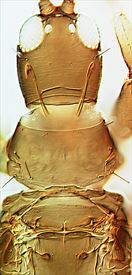Distinguishing features
Both sexes fully winged. Body brown; tarsi, apical half of fore tibiae, antennal segments III–V, and proximal half of VI yellow; major setae brown; fore wings pale, dark at extreme base. Head about as wide as long, with weak lines of sculpture near posterior margin; ocelli well developed; compound eyes as large dorsally as ventrally; postocular setae blunt; maxillary stylets reaching to postocular setae, about one-third to one-half of head width apart; maxillary bridge wide. Antennae 8-segmented; segment III with 1 sense cone, IV with 4. Pronotum with anteromarginal setae small, finely acute; remaining major setae broadly blunt or weakly expanded; basantra present. Mesopresternum broadly boat-shaped; metathoracic sternopleural sutures absent. Foretarsal tooth very small. Fore wings with 7–10 duplicated cilia; major sub-basal setae S3 pointed, S1 and S2 shorter, blunt. Pelta bearing small lateral lobes; tergites II–VII each with 2 pairs of sigmoid wing-retaining setae; tergite IX posteromarginal setae acute; tube shorter than head.
Male not recorded from New Zealand.
Related species
The genus Haplothrips comprises 240 described species worldwide, of which only four are recorded from New Zealand, and none of these seems to be endemic. H. kurdjumovi is closely related to the common European species H. subtilissimus, but the females of that species lack a fore tarsal tooth. Due to the pale colour of the antennae and long pointed setae on tergite IX, kurdjumovi can also be confused with H. gowdeyi, but that is an unrelated species with two sense cones on the third antennal segment.
Biological data
This species is predatory on the eggs of mites, and is most frequently collected in orchards.
Distribution data
Presumably introduced to New Zealand (AK, WO, GB, HB / CO), this species is widespread across the northern hemisphere and is also common in Hawaii.
Family name
PHLAEOTHRIPIDAE, PHLAEOTHRIPINAE
Species name
Haplothrips kurdjumovi Karny
Original name and synonyms
Haplothrips kurdjumovi Karny, 1913: 8.
Haplothrips faurei Hood, 1914: 157.
Haplothrips floricola Priesner, 1921: 14
References
Minaei K & Mound LA (2008) The Thysanoptera Haplothripini (Phlaeothripidae) of Iran. Journal of Natural History 42: 2617–2658.
Mound LA & Walker AK (1986) Tubulifera (Insecta: Thysanoptera). Fauna of New Zealand 10: 1–140.


